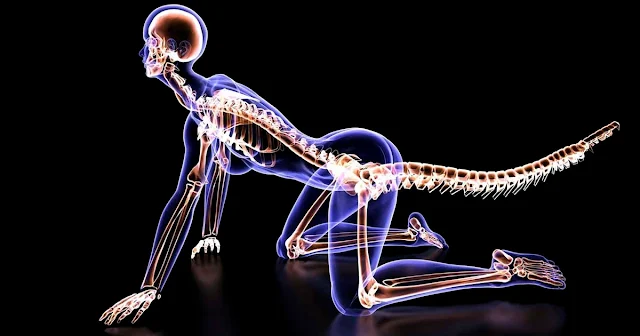One of the most remarkable changes in human evolution is the loss of our tails, a transformation that occurred around 25 million years ago. This pivotal shift not only altered the trajectory of our species but also marked a significant moment in the evolutionary history of primates. While scientists have long speculated on why humans lost their tails, the genetic cause has remained elusive—until now. A recent study published in Nature has finally uncovered the genetic factors responsible for this evolutionary change.

The Quest to Understand Tail Loss
The journey to unravel the mystery of human tail loss began in an unexpected way. Bo Xia, a graduate student at New York University, was inspired to investigate the origins of the human tailbone after injuring his own coccyx. This personal curiosity led Xia and his team to embark on a groundbreaking scientific investigation.
Through careful research, the team focused on the TBXT gene, which plays a crucial role in regulating tail length in various species. Their research revealed a unique genetic mutation within this gene, providing a major breakthrough in understanding human evolution.
The Role of Jumping Genes
A key aspect of this discovery lies in the role of Alu elements, often called “jumping genes.” These genetic elements, specific to primates, can move within the genome and cause significant changes. The researchers found that Alu elements inserted themselves into the TBXT gene, triggering a chain reaction that led to the loss of our tails.
This insertion activated a process known as alternative splicing, where RNA molecules are cut and restructured, which ultimately led to the deletion of a crucial exon. This change altered the structure and function of the resulting protein, leading to the tail loss seen in humans.
Validation Through Mice Studies
To confirm their findings, the researchers engineered laboratory mice with the same genetic mutations found in humans and apes. These genetically altered mice lost their tails, providing compelling evidence that the identified mutation plays a crucial role in the absence of tails in humans and other primates.
However, the study also uncovered a downside to tail loss: an increased risk of neural tube defects, such as spina bifida. This finding highlights the complex balance between evolutionary benefits and potential genetic trade-offs.
The Broader Implications
This discovery has profound implications not just for understanding human evolution, but also for human anatomy and health. The loss of our tails was not a random event but a genetic adaptation with lasting consequences. It illustrates the complex relationship between genetic changes and the way they shape our physiology over time.
As we continue to study our evolutionary past, these findings remind us of the intricate process of natural selection and genetic innovation that has shaped humanity. This breakthrough also underscores the power of scientific inquiry in uncovering the mysteries of our origins, offering insight into the past that can help us understand our future.
The identification of the genetic reasons behind tail loss is a testament to the persistence of scientific exploration and the ongoing quest for knowledge about our evolutionary journey.
Unlock The Mystical Power Of An Antique Relic
The prospect of finding something new is one of the most thrilling aspects of moving into an old house.
Many interesting items have been discovered by people concealed in their attics, basements, walls, or floorboards. One peculiar antique artifact was discovered in a 100-year-old house.
An antique marble razor blade sharpener that defies expectation in

Confused with a Toy
Based on its appearance, this antique relic looks like a popular children’s toy from the 1960s and 1970s. Some have mistaken it for “Clackers.” As a result, there has been much discussion regarding the object’s true origins. But the clackers were constructed out of plastic acrylic balls and string. In the meantime, the old artifact is made up of two glass marbles with a steel rod and a wooden or metal base.
What then is the purpose of the antique razor blade sharpener? As implied by the name, it was a razor blade sharpening tool in the 1930s. Although not much appears to be known about the antique relic’s past, its elaborate design demonstrates the skill with which handcrafted items were made at the period. A lovely reminder of things we don’t see very often these days.

There are many different ways that shaving has been done throughout history. From shark teeth and clam shells to bulky metal items packaged in cute little kits to disposable 4-5 bladed razors and electric razors, razors have evolved over time. Today, the majority of men and women engage in what was formerly considered a status and wealth symbol.
Shaving’s origins can be traced back to at least 4000 BCE, according to historians. In fact, shaving with sharpened flint and shells has been depicted in cave paintings. Furthermore, razors made of copper and solid gold have been discovered in Egyptian tombs.
As shaving has gained popularity, innovative designs have added more blades to a single razor, implementing designs for safety and precision.
Filling an Important Role

The vintage marble razor blade is still a very useful and stylish tool to have around, despite its apparent obsolescence. These days, they are still useful for honing knives and straight-edged razors.
In addition to being extremely simple to use, the razor sharpener maintains its polish throughout, providing an even sharpening, in contrast to modern sharpeners that can also become jagged and prickly. To keep knives and razors sharp, just run the blade between the two marbles a few times.
Remarkably, historians and antique collectors who value the skillfully made implements of the past also find great appeal in this relic. Many Reddit users have reported finding the vintage marble razor blade sharpener in old boxes in the garage, among other places, despite the paucity of information available. Many have inquired about it and received informative—if not occasionally humorous—answers.

“I knew this one! My grandfather told me stories of selling these door to door when he was young during the Great Depression. They don’t really work at all, but he said he would have a new blade palmed and ask the customer for one of their old blades to demonstrate – he’d swap in the fresh blade to show what a good job it did, and then take off quick after a sale!” One commented.
“It’s called a Kenberry blade sharpener. this is the only image i can find that proves that. they didn’t work that well, so a bunch of people had them laying around and put it to different uses.” Said another.
Meanwhile, someone suggested another possible use for the tool. “Not a razor blade sharpener. It is a holder for a dish towel. It goes on a cabinet handle. The towel slides in and out very easily. This one was my grandmother’s. She sold them in her grocery store back in the 60’s. (next to the dish towels.)”
Given how old the tool is, it might be challenging to determine its precise function. In any case, it’s a stunning work of handcrafted history that, if nothing else, is a fascinating conversation starter.



Leave a Reply